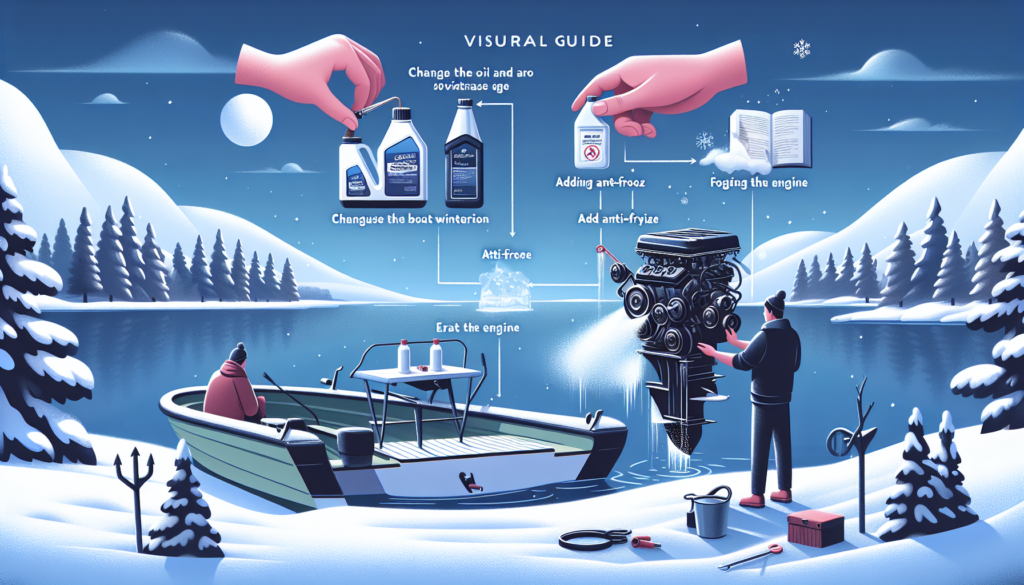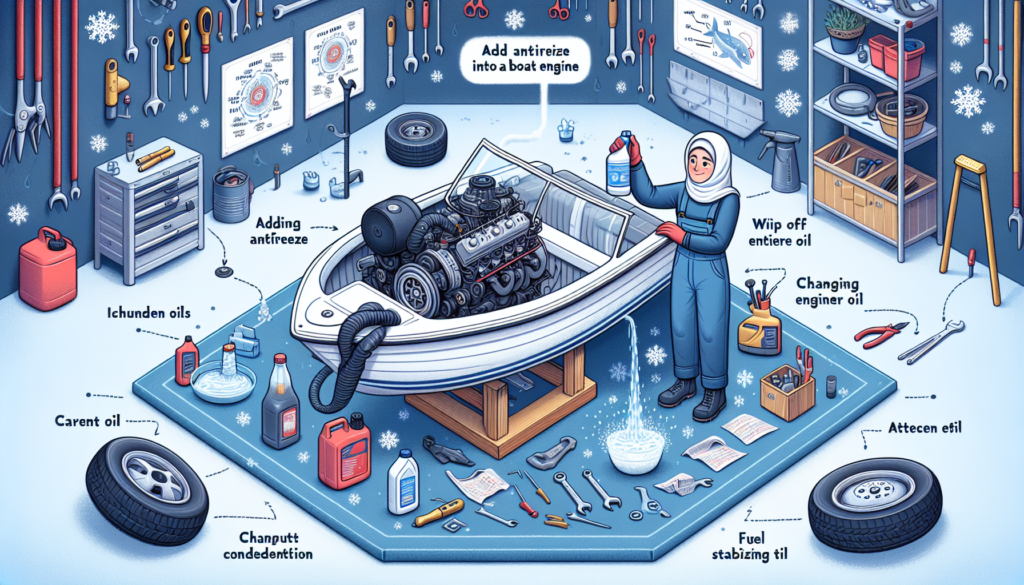As a boat owner, facing the biting chill of winter requires careful preparation, and your boat’s engine is no exception. “The Ultimate Boat Engine Winterization Guide” provides all the tips and information you need to protect your vessel’s powerhouse. From detailing the precise steps for draining the coolant system to discussing the importance and process of fogging the engine; this guide covers a range of pertinent topics. Get ready to learn all the secrets to extending the lifespan of your boat engine and saving on potential costly repairs.

Understanding the Importance of Boat Engine Winterization
Boat engine winterization is a critical task for boat owners who wish to maintain the overall health and function of their boat, particularly in colder climates. Winterizing your boat engine can mean the difference between a great summer on the water or facing costly repairs that could delay or ruin your boating season.
Reasons to winterize your boat engine
There are many reasons to winterize your boat engine. The primary reason is to protect the engine from damage caused by freezing temperatures. Cold weather can wreak havoc on a boat engine, especially if water gets into the engine and freezes. This can cause the engine to crack or other severe damages that can be expensive to repair. Moreover, winterizing your boat helps maintain its performance, extends its longevity, and keeps any applicable warranties valid.
Potential damage from not winterizing your boat engine
Failure to properly winterize your boat engine can lead to a plethora of potential problems. As earlier mentioned, water in your engine can freeze and expand, leading to serious damages like cracked engine blocks or manifolds. Corrosion and rust can also occur due to unused and stagnant fluids in the engine. Furthermore, unused fuel can degrade and gum up the fuel system, leading to a failure to start and run properly come spring.
Benefits and cost-effectiveness of boat engine winterization
Beyond preventing expensive damages and preserving your boat’s lifespan, winterizing your boat offers several benefits and cost-effectiveness. For one, it prepares your boat for a quicker, hassle-free start-up when boating season resumes. It also affords you the time to handle other maintenance tasks, which might be challenging to do during active boating season. Considering these benefits against the potential costs of repairs from lack of winterization, it becomes clear that winterization is indeed cost-effective.
Boat Engine Types and their Winterization Needs
Just like cars, boats also have several types of engines that each have unique winterization needs. It’s essential to understand your engine’s specific needs to ensure adequate winterization and protection.
Overview of different boat engine types
There are several types of boat engines, including inboard, outboard, stern-drive, and jet drive engines. Each of these engines operates differently and hence, requires different maintenance and winterization procedures.
Specific winterization needs for each engine type
Winterization processes slightly differ based on the boat engine type. For instance, inboard engines may require fogging oil application, while outboard engines might need lower unit oil changes. Stern-drive engines often need additional care in winterizing the drive unit, while jet drive engines may require special attention to remove all water to prevent freezing.
Understanding if your engine type affects the winterization process
Absolutely, knowing the type of engine you have significantly impacts how you should winterize your boat. Each type of engine has its unique features and systems, which therefore require specific maintenance processes when winterizing. Always refer to your manufacturer’s guidelines to understand your engine’s winterization needs.
Preparation Steps for Winterization
Knowing the processes and steps to winterize your boat engine isn’t complete without adequate preparation. Here are three essential preparation steps you must take.
Gathering the necessary tools and materials
Winterizing your boat requires a set of necessary tools and materials, such as antifreeze, oil and filter, fogging oil, a garden hose and ear muffs, fuel stabilizer, and several others. You might also require wrenches, screwdrivers and oil extractor pumps.
Reading up on your boat’s manual
Every boat and engine come with specific manufacturer instructions. It’s essential to read up on your boat’s manual to understand the manufacturer’s winterization recommendations. The manual often provides specific information on all tasks and materials involved in winterizing your boat type.
Ensuring appropriate workspace and protective gear
Remember to always work in a well-ventilated, spacious, and dry workspace to prevent accidents or damages. Wearing protective gear is also advised to prevent exposure to harmful gases, chemicals, and accidents.
Checking Your Boat’s Condition Pre-Winterization
It’s important to thoroughly check your boat and its engine for any pre-existing issues before commencing the winterization process.
Inspecting for existing damages
Begin with a comprehensive examination of your boat, looking out for any visible damages or wear and tear: blisters, hull cracks, rust, etc. Noting these down will help you plan for necessary repairs before or after winterizing your boat.
Checking for water leaks
Water leaks can be particularly damaging if not taken care of before winter sets in. Be sure to check your boat’s hull, plumbing system, and engine for any signs of leaks.
Evaluating the boat’s electrical system
The boat’s electrical system, including lights, radio, GPS, and other devices, should be in proper working order. Electrical issues can lead to severe problems if left unattended over the winter period.
Checking the fluid levels
Ensure all fluid levels like engine oil, coolant, drive lube, and power steering fluid are at the correct levels before starting the winterization process. Some of these fluids may need to be drained and replaced during winterization.

Cleaning the Boat Engine
Just like your boat’s exterior, the engine also needs to be thoroughly cleaned before winterization for optimal results.
Proper technique to clean boat engine
Cleaning your boat engine involves removing debris, oil, or any contaminants. A pressure washer or engine degreaser could be used for this task. However, unless you are experienced with this, it’s recommended to have professionals handle it as improper cleaning can cause damages.
Types of cleaning solutions to use
Engine cleaners or degreasers are available in most auto shops. They are designed to safely eliminate grease, grime, dirt, and other substances that can harm your engine.
Importance of a clean engine pre-winterization
A clean engine allows you to see and address any minor issues before they become significant problems. It also ensures that grime and contaminants won’t sit on your engine all winter, which could lead to corrosion or other damages.
Draining and Changing the Fluids
Draining and changing your engine’s fluids is one of the most critical steps in the winterization process, as these fluids, if left over winter, can lead to severe engine damages.
How to drain engine oil
Your boat’s engine oil can be efficiently drained using an oil extractor pump. Always remember to use an appropriate container for the used oil and dispose of it safely at a recycling facility.
How to replace antifreeze
After draining the old antifreeze, you can replace it with a fresh one by pouring it into the correct reservoir. Be sure to use marine-grade antifreeze rated for the temperatures in your winterization location.
Why changing the fluids is necessary for winterization
Old fluids often contain impurities and contaminants gathered over the boating season. If left in your engine over winter, these impurities can cause corrosion, damages, and degradation of your boat’s vital engine parts.

Fuel Stabilization
Fuel stabilization is another crucial step in the winterization process. It prevents the fuel in your boat from deteriorating and causing damages to your engine.
The process of fuel stabilization
This process involves adding an appropriate amount of fuel stabilizer to your boat’s fuel, followed by running your boat for about 15 minutes to circulate the stabilizer throughout the system.
Fuel stabilizer types and how to use them
There are many types of fuel stabilizers available. Always choose one suitable for your fuel type – gasoline or diesel. Follow the manufacturer’s instructions on how much stabilizer to use per gallon of fuel.
Why fuel stabilization is important
Fuel stabilization is crucial as, over time, untreated fuel breaks down and forms deposits that could clog your engine’s fuel system, potentially leading to expensive repairs.
Dealing with the Battery
The boat’s battery also needs particular attention before storing your boat for winter to ensure it remains in good condition and ready to go for the next boating season.
Methods to protect the battery
The battery’s lifespan can be extended by keeping it fully charged and clean, preventing self-discharge and corrosion. Remove, clean, and apply a protective spray to the battery connections to prevent corrosion.
When and why to disconnect the battery
It’s best to disconnect the battery if you won’t be using your boat for an extended period in winter. This helps prevent it from draining and being damaged from severe cold.
Battery storage tips
Store your battery in a cool and dry place off the ground. Maintain it by trickle charging it every 4-6 weeks using a marine battery charger to ensure it stays in optimal condition.
Covering and Storing the Boat
The way you cover and store your boat over winter can significantly impact its condition come springtime.
Options for different types of boat covers
Boat covers range from fitted covers to tarps. The important thing is to choose a cover that’s breathable to prevent moisture buildup, and sturdy enough to withstand harsh winter weather.
Ideal storage locations
The ideal storage location for your boat is indoors in a controlled environment. However, if that’s not available, use a boat cover and store your boat somewhere dry and shielded from harsh weather.
Preparations before covering and storing
Before covering and storing your boat, ensure to clean it thoroughly, both inside and outside. Also, open lockers, drawers, and doors to allow airflow and prevent mold and mildew from developing.
Maintenance and Checkups During Winter
Even after winterizing, your boat will still benefit from regular checks and maintenance throughout the winter period.
Why regular checkups are important during winter
These occasional checkups ensure that the winterization steps are still effective, and no unforeseen problems have popped up like leaks or pests.
What to look out for in these checkups
During these checkups, look out for any signs of moisture, pests, deteriorating tarps, or covers. Ensure to also check the bilge for any water build-up.
Tips for maintaining your boat during winter
To maintain your boat during winter, frequently air it out on dry days to prevent stale air. Regularly check tire pressure if it’s trailer stored, and ensure the covers are secure.
In conclusion, winterizing your boat engine is essential to protecting your investment and ensuring many wonderful boating seasons to come. It takes time, patience, and labor, but the peace of mind and savings it provides are well worth the effort. Happy winterizing!

